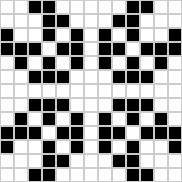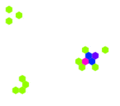Conway's Game of Life facts for kids
The Game of Life is like an imaginary robot game. It's a special type of cellular automaton, which means it's a grid of cells that change based on simple rules. A famous British mathematician named John Horton Conway created it in 1970.
It's called a "game" because you can set it up in many ways. You choose how the cells start, and then you watch what happens. The Game of Life is a zero-player game. This means that once you set it up, it runs by itself without anyone needing to play.
Contents
How to Play the Game of Life
The game happens on a grid of squares called cells. Each cell can be either black (alive) or white (dead). To start, you make some dead cells alive. Then, the alive cells follow rules to change other cells.
The Rules of Life
Here are the four simple rules:
- An alive cell with less than two alive neighbors dies. It's like being too lonely.
- An alive cell with four or more alive neighbors dies. It's like being too crowded.
- An alive cell with two or three alive neighbors stays alive. It's just right!
- A dead cell with exactly three alive neighbors becomes alive. It's like a new cell is born.
You set up the first alive cells to begin the game. Then, you apply these rules to create the next "generation" or level. You keep doing this over and over. The game ends when all cells are dead, or all cells are alive, or the pattern starts repeating itself. The Game of Life is also Turing-complete. This means it can do anything a computer can do, given enough space and time.
The History of the Game
John Horton Conway made the Game of Life because he wanted to see if simple cells could grow and become more complex. He used many math ideas to create the rules. It was one of the first "simulation games." These games show how things might happen in the real world. The Game of Life is important because it can help us understand things in physics, biology, economics, and even philosophy.
Amazing Patterns in the Game
Special things often happen in the game, and we call these "patterns." There are different kinds of patterns:
- Static patterns: These patterns don't change at all between levels.
- Repeating patterns: These patterns show the same alive and dead cells over and over.
- Moving patterns: These patterns, called "spaceships," move across the grid.
Here are some common patterns you might see:
| |
|
|
|
|
 |
 |
| Block | Boat | Blinker | Toad | Glider | LWSS | Pulsar |
The "block" and "boat" patterns never change. The "blinker" and "toad" patterns repeat every two levels. The "glider" and "lightweight spaceship" ("LWSS") are spaceships that move across the grid. The "pulsar" [1] is a repeating pattern that takes three levels to repeat. Most repeating patterns, like the blinker, repeat every two levels.
Different Ways to Play Life
Since the original Game of Life was made, people have created new versions. These versions often have different rules for cells becoming alive or dead. Some variations also change how the cells look or where they are placed on the grid.
Two-Player Game of Life
In a two-player version of the Game of Life, the alive cells have two different colors. A player wins when their color takes over all the cells. When a dead cell becomes alive, its color matches the alive cells around it. If both colors are touching the new cell, the color that touches it more wins.
Images for kids
-
The 6366548773467669985195496000th (6×1027) generation of a Turing machine, made in the Game of Life. This was calculated very quickly using special software.
See also
 In Spanish: Juego de la vida para niños
In Spanish: Juego de la vida para niños








